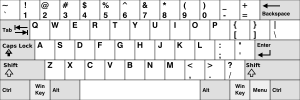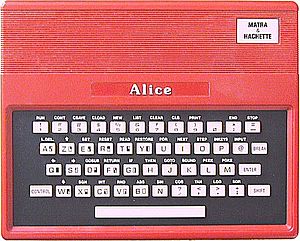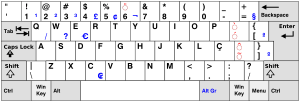QWERTY facts for kids
The QWERTY keyboard layout is very common for computers and typewriters. You can find it in many English-speaking countries. The name "QWERTY" comes from the first six letters on the top row of keys: Q, W, E, R, T, and Y. Christopher Sholes patented this design in 1874. He then sold it to a company called E. Remington and Sons that same year.
Contents
How the QWERTY Keyboard Started
Christopher Sholes invented the QWERTY layout. He also created the first modern typewriter. At first, typewriters had letters arranged in alphabetical order. But when people typed fast, the metal bars holding the letters would get stuck together. This meant the typist had to stop and pull them apart.
A friend of Sholes, James Densmore, suggested a new layout. He thought spreading out the keys would stop the bars from sticking. This would make typing faster and smoother. Some people think QWERTY was made to slow typing down. Others believe it worked by separating common English letter pairs.
Typing Special Characters and Accents
The QWERTY keyboard was designed for the English language. English words do not use accent marks. This caused problems for people in other countries. Languages like French use letters with accents, such as "é" or "ç".
You can often type accent marks using special key combinations. For example, you might hold down the Alt key and press certain numbers. Releasing the Alt key would then create the special character. Sometimes, you can use the Control or Alt key with a letter.
Many word processing programs, like Microsoft Word, have "Special Characters" menus. You can find and insert accent marks there. Windows computers also have a "Character Map" program. This tool lets you find and copy any character. You can then paste it into other programs.
Different QWERTY Keyboards Around the World
Keyboards can look different depending on where they are made. Even if they are based on QWERTY, they often have changes for local languages.
Belgian and French Keyboards
Keyboards in Belgium and France are called AZERTY keyboards. They swap the Q and W keys with the A and Z keys. The letter M is also moved to the right of the L key.
Czech Keyboards
Some Czech keyboards use a QWERTZ layout. They switch the Z and Y keys, just like German keyboards. They also add special Czech letters like "ů" and "ú" near the P and L keys. The top row, which usually has numbers, has accent marks instead. To type numbers, users must hold down the Shift key.
Keyboards in Denmark and Norway have the letters Æ, Ø, and Å. Swedish and Finnish keyboards use Ä and Ö instead. These letters are placed where other special characters might be on a standard QWERTY keyboard.
Faroese Keyboards
Faroese keyboards add the letters Æ and Ø next to the L key. They also add Å and Ð next to the P key.
German Keyboards
German keyboards are QWERTZ. They switch the Z and Y keys because Z is used more often than Y in German. They also add Ü to the right of P, and Ö and Ä to the right of L.
Hungarian Keyboards
Hungarian keyboards add É and Á after L. They place Ö above O, Ü above P, and Ő after P. Ú is found after Ő, Ó above Ú, and Í under A. Like German, they also switch Z and Y.
Icelandic Keyboards
Icelandic keyboards add Ð to the right of P. Æ is to the right of L. Ö is to the right of the 0 key on the top row. Þ is placed at the far right of the bottom row.
Italian Keyboards
Older Italian typewriters used a QZERTY layout. The Z was swapped with W, and M was to the right of L. Modern Italian computer keyboards are QWERTY. They add è to the right of P and ò to the right of L.
Lithuanian Keyboards
Lithuanian keyboards use an ĄŽERTY layout. Ą is where Q usually is, and Ž is where W usually is. The Q and W keys can still be found, often on the far right or by using the Alt Gr key. Sometimes, Lithuanian symbols replace the numbers on the top row.
Portuguese Keyboards
Portuguese keyboards keep the QWERTY layout. They add the Ç key after the L key. The Spanish version of this keyboard has the Ñ key.
Romanian Keyboards
Romanian keyboards have a QWERTZ layout, so Y and Z are swapped. They add ă and î to the right of P. Ş and ţ are added to the right of L. The â replaces the backslash character. Some symbols on the number keys are also moved around. For example, the hyphen (-) is swapped with the slash (/).
Spanish Keyboards
Spanish keyboards add the ñ and Ñ characters. These are placed to the right of the L key, where the semicolon and colon usually are.
Turkish Keyboards
Turkish keyboards add Ğ and Ü to the right of P. Ş and İ are added to the right of L. Ö and Ç are placed to the right of M.
Images for kids
-
A Modern Greek keyboard layout.
-
A Romanian keyboard layout.
-
United Kingdom Extended Keyboard Layout for Windows.
See also
 In Spanish: Teclado QWERTY para niños
In Spanish: Teclado QWERTY para niños










